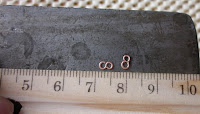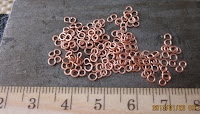I've been busy, but not busy posting so I'm dropping a few posts onto the blog all at one time. This post was sort of an after thought. Wasn't really a project on my list and wasn't really inspired by any sort of period reference. Long story short, I went to Tandy leather to look for a rawhide mallet and was very disappointed by the price they were asking. I found that some of my metal stamps I made were starting to mushroom on the top from using a metal hammer and so I decided to get a mallet. The ones at Tandy were pretty, but pricy. Yuck. I thought to myself, "dang, how tough would it be to make one of those?"
I dug around in the basement for an old dog chew rawhide I knew I had. At one point, maybe 9 years ago, I planned on experimenting with making some armor out of rawhide. I bought a dog bone from a pet store and soaked it in water for a while. When soft enough I stretched it out and let it dry to see how easy it was to play with. Worked well enough, but for some reason I decided against ever doing anything with it, so there the unrolled dog bone sat for some years.
With no testing and no real plan I placed the rawhide into a big pot and boiled it up. It didn't actually fit in the pot. Took some doing to bend it enough to fit into my 4 quart pot. Once it got to boiling I turned down the heat and let go for about 15 minutes. Then I thought to myself… "crap, now what?" I ran and got some twine from the garage and figured I just roll it up and tie it off and let it dry. When the rawhide was done boiling I rinsed in cool water enough that I could handle it without gloves and not scream too loudly. The rawhide thickened up a LOT! I tried rolling it up and had some problem getting it started. In hind sight by placing one end in a vice I might have been able to pull it tighter as I rolled it. I was now in a bit of a rush. I had used our kitchen cookware and my wife hates when I "do projects" with the good stuff. I had my eleven year old daughter sand on one end of the rawhide as I pulled very hard to stretch it out as I rolled it up. Worked well enough after she learned to keep her balance during my tugging.
I was rather surprised how well the ends even looked. Turns out the one end is a bit thicker than the other. I don't think the thickness of the rawhide was consistent. Oh well, just a test.
As I looked at it I decided that the mallets at Tandy were a lot smoother and prettier. I should trim it now while the rawhide i soft. NOPE. Don't do it. I did it and yes, it looks nicer... at first.
The images above were taken about 30 minutes after the rolling adventure ended. I liked the tightness and the cleanliness of the end, but in the images below you can see that as it dried the nice smooth surface changed. I should have probably just waited until the whole thing dried through and then take a saw to it. Looks like I'll have to do that anyway. These images were taken a few days of drying and a little bit of heating.
Ever impatient I started to wonder if the center would dry at the same rate. I was wondering if the outside dried and the center didn't would it start to rot? I resolved to speed up the process. I placed the mallet head into a toaster over at about 150~200 degrees for about 2 hours. I checked it every 15 minutes or so. No issues seemed to arise. I did that again three days later. Still nice and tight. So far so good.
The images below are from the last heating. I took the twine off since it was starting to burn a little and the mallet head shrunk enough so that the twine didn't do anything any longer anyway. I heated the mallet to 250 for an hour and called it done. I'm probably going to let this sit for a while before drilling it out. The surface is VERY hard and still solid enough to use as a mallet for leather working. I have used it without a handle already and it works fine.
All in all I'm rather happy with the experiment so far. Next time I think I would keep better notes. I think the whole project took only 3~4 days or so and only a small amount of real work. I will probably make another of these, only bigger and with more prep work to help in the rolling of the hot rawhide. This one I think I'll use for metal working. I'll leave one side flat and round the other side up for dishing. I have a copper and brass project I'm working on and a soft headed rawhide mallet might be just the trick for dishing the metal with little damage to the surface.

























.jpg)








































